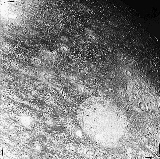
Memphis Facula
Encyclopedia

Palimpsest (planetary astronomy)
A palimpsest, in planetary astronomy, is an ancient crater on an icy moon of the outer Solar System whose relief has disappeared due to creep of the icy surface or subsequent cryovolcanic outpourings, leaving a circular albedo feature, perhaps with a "ghost" of a rim...
, or "ghost crater", on Ganymede
Ganymede (moon)
Ganymede is a satellite of Jupiter and the largest moon in the Solar System. It is the seventh moon and third Galilean satellite outward from Jupiter. Completing an orbit in roughly seven days, Ganymede participates in a 1:2:4 orbital resonance with the moons Europa and Io, respectively...
, the largest of the Jovian satellites.
Some 340 km across, it is situated in the south western part of Galileo Regio
Galileo Regio
Galileo Regio is a large, dark surface feature on Jupiter's moon Ganymede.Contrary to the first impression, Galileo Regio is not an impact crater but a region of ancient dark material that has been broken apart by tectonism and is now surrounded by younger, brighter material that has been upwelling...
, a huge almost circular dark region on Ganymede
Ganymede (moon)
Ganymede is a satellite of Jupiter and the largest moon in the Solar System. It is the seventh moon and third Galilean satellite outward from Jupiter. Completing an orbit in roughly seven days, Ganymede participates in a 1:2:4 orbital resonance with the moons Europa and Io, respectively...
's north eastern flank. Although almost level today, it is a relic of a massive impact and once was a deep impact crater whose walls have slumped and its floor has risen isostatically, smoothing out the remaining topography with slush.
The morphology of the larger palimpsests like Memphis Facula suggests that Ganymede
Ganymede (moon)
Ganymede is a satellite of Jupiter and the largest moon in the Solar System. It is the seventh moon and third Galilean satellite outward from Jupiter. Completing an orbit in roughly seven days, Ganymede participates in a 1:2:4 orbital resonance with the moons Europa and Io, respectively...
's icy crust at the time of impact was about 10 km thick and was penetrated by the impact, allowing the slush and fluid beneath to fill and level out the crater.

